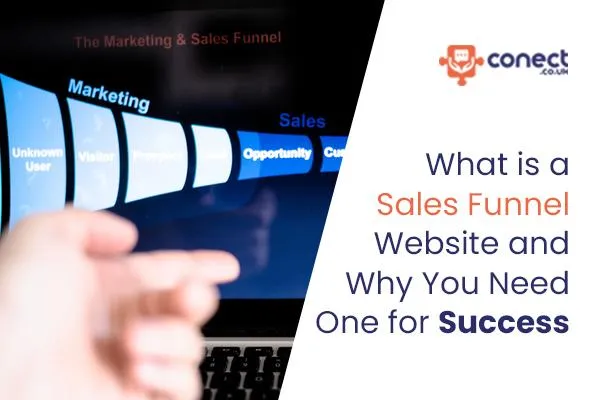
What is a Sales Funnel Website? Essential Guide for Success
What is a Sales Funnel Website and Why You Need One for Success
A sales funnel website is a crucial tool for businesses aiming to convert website visitors into paying customers. By understanding what a sales funnel is and how it works, you can optimize your website to effectively guide potential customers from the awareness stage all the way to making a purchase. A well-designed sales funnel not only attracts leads but also nurtures them, builds trust, and ensures a seamless journey towards conversion.
The Basics of a Sales Funnel Website
A sales funnel website is more than just a place to showcase your products or services; it’s a strategic tool that systematically guides visitors through a series of steps designed to turn them into paying customers. Think of it as a virtual path that starts with attracting visitors and ends with them making a purchase or taking the desired action.
At its core, a sales conversion website consists of several stages that encourage visitors to move from one step to the next. These stages typically include awareness, interest, decision, and action. By optimizing each of these stages, your website becomes a powerful asset for converting leads.
Why a Sales Conversion Website is Crucial for Your Business
A sales funnel website is an essential part of any successful digital marketing strategy. Here’s why:
1. Automates the Customer Journey
A sales pipeline website automates the customer journey, which helps you work smarter, not harder. By guiding leads through the funnel, it minimizes the need for manual intervention and ensures that potential customers are consistently nurtured. This automated process frees up time, allowing you to focus on other aspects of your business.
2. Increases Conversion Rates
A well-structured sales funnel can significantly improve your website's conversion rates. By leading visitors step by step through the funnel, you are more likely to convert them into paying customers. Each stage of the funnel is strategically designed to keep the customer engaged and moving towards a purchase.
3. Builds Stronger Relationships
A sales pipeline website allows you to engage with leads at every stage of their journey. By offering value and addressing pain points along the way, you can build stronger, more trust-based relationships with your customers. This not only helps convert first-time buyers but also encourages repeat business.
The Key Stages of a Sales Pipeline Website
To build an effective sales pipeline website, you must understand the stages that lead to a successful conversion. Here’s a breakdown of the key stages:
1. Awareness: The Top of the Funnel (TOFU)
At this stage, visitors become aware of your brand or product. They may have found your website through a Google search, social media post, or an online ad. The goal here is to capture their attention and provide them with useful information that encourages them to learn more.
How to Drive Awareness:
Blog posts
Social media campaigns
SEO strategies
Paid ads
By offering free, valuable content and solving a problem, you can increase traffic to your website and drive awareness.
2. Interest: Moving Leads Toward Consideration
Once visitors are aware of your brand, the next step is to nurture their interest. At this stage, you want to give them more information about your products or services, making it clear how your solution meets their needs.
How to Build Interest:
Lead magnets (eBooks, checklists)
Free webinars or demos
Email campaigns
Case studies and testimonials
By showing value and offering relevant content, you can deepen their interest and move them closer to making a decision.
3. Decision: Guiding Leads to the Purchase Decision
At the decision stage, visitors are evaluating whether or not to make a purchase. They may have compared your products with competitors and are now considering making a decision. Your goal here is to encourage them to act by offering additional incentives.
How to Influence the Decision:
Product comparisons
Special offers (discounts, bonuses)
Clear and persuasive calls to action
Customer testimonials and social proof
By providing extra value and demonstrating why your offering is the best, you can help push leads toward purchasing.
4. Action: Conversion Stage
The final stage of the funnel is where visitors take action—whether it’s making a purchase, signing up for a service, or another desired outcome. It’s essential to make this process as easy and smooth as possible.
How to Encourage Action:
Simple checkout process
Clear CTAs (e.g., “Buy Now”)
Multiple payment options
Post-purchase follow-up and incentives for repeat business
This is where the magic happens, so make sure your calls to action are clear and that the process is as frictionless as possible.
How to Optimize Your Sales Funnel Website
Building a sales pipeline website is one thing, but optimizing it for conversions is another. Here are a few tips to ensure your funnel works as effectively as possible:
1. Use Engaging Content at Each Stage
Your content should be tailored to each stage of the funnel. At the awareness stage, focus on educational and value-driven content. In the decision stage, provide more detailed product information, and in the action stage, encourage easy decision-making with persuasive CTAs.
2. Personalize the Experience
Personalization is a powerful tool for increasing conversions. Use lead segmentation to send tailored messages based on a visitor’s behavior or interests. For example, if someone has downloaded a product guide, follow up with an email offering a limited-time discount.
3. Test and Optimize
Testing different elements of your sales pipeline website can help you identify what works best for your audience. A/B test headlines, CTAs, landing pages, and even email subject lines to see what leads to better conversion rates.
4. Track Metrics and Analyze Performance
Regularly track your sales funnel performance to identify areas for improvement. Use analytics tools to measure metrics such as conversion rates, bounce rates, and click-through rates, and adjust your funnel accordingly.
Integrating Social Proof into Your Funnel Landing Pages
Social proof is a psychological phenomenon where people are influenced by the actions of others. Incorporating social proof into your sales pipeline website can significantly increase trust and drive conversions.
Customer Reviews and Testimonials
Displaying customer reviews or testimonials on product pages or landing pages can encourage potential customers to make a purchase. When visitors see that others have had positive experiences, it reassures them about their own potential purchase.
User-Generated Content
User-generated content (UGC) such as photos, videos, or social media posts from satisfied customers can also serve as powerful social proof. Encourage your customers to share their experiences, and feature this content throughout your funnel.
How a Funnel Landing Page Boosts Customer Retention
A funnel landing page is not just about acquiring new customers; it’s also about retaining them. By effectively guiding visitors through the funnel, businesses can create a personalized experience that nurtures long-term relationships. Retention is crucial because retaining customers is more cost-effective than acquiring new ones.
Building Loyalty with Follow-up Strategies
After the purchase, continue engaging with your customers through follow-up emails, special offers, or loyalty programs. A funnel landing page can automate this process and ensure customers feel valued, leading to repeat business.
The Role of Post-Purchase Support in Retention
Provide customers with continuous support after their purchase. This could include product tutorials, FAQs, or customer service outreach. A funnel landing page can guide customers to these resources, improving their overall satisfaction.
Conclusion
A sales funnel website is a vital tool for businesses looking to optimize their online presence and increase conversions. By creating a streamlined process that guides visitors through the funnel, you not only increase your chances of making a sale but also build a lasting relationship with your customers.
Designing and optimizing a funnel landing page is key to business growth. With the right strategies in place, you can convert casual visitors into loyal customers and drive significant revenue.
FAQs
1. What is the main goal of a funnel landing page?
The main goal is to guide visitors through a series of stages that increase their likelihood of making a purchase or taking a desired action.
2. How long should my sales funnel be?
The length of your funnel depends on your business and audience. For complex products, it may be longer, but keep it simple for quick conversions.
3. Can I use a funnel landing page for services, not just products?
Yes, a sales funnel can be designed for services as well. The key is to educate your leads and guide them through the decision-making process.
4. How do I drive traffic to my conversion funnel website?
Use SEO strategies, paid ads, content marketing, and social media to drive traffic to your website and increase awareness.
5. Can a funnel landing page work for B2B businesses?
Absolutely. A sales funnel can be highly effective for B2B businesses, though the funnel may have longer decision-making stages and involve more personalized interactions.
6. How do I know if my sales funnel is working?
You can measure the success of your sales funnel by analyzing key performance metrics such as conversion rates, bounce rates, and lead generation. Regularly track these metrics to identify strengths and areas for improvement.
7. How often should I update my funnel landing page?
It’s essential to review and update your sales funnel regularly. Consider making adjustments based on performance data, changes in customer behavior, or new marketing trends to keep the funnel optimized for conversions.
8. Can I integrate my sales funnel with email marketing?
Yes, email marketing is a crucial component of a sales funnel. You can use email automation to nurture leads, offer incentives, and remind visitors about abandoned carts, all while guiding them through the funnel.
9. How do I make my sales funnel mobile-friendly?
Ensure your funnel landing page is fully optimized for mobile devices. Use responsive design, fast-loading pages, and simplified forms to provide a seamless experience for visitors on smartphones and tablets.
10. Do I need a conversion funnel website if I already have an online store?
Yes, even if you have an online store, a funnel landing page can help you attract more targeted leads and nurture them through personalized stages before they make a purchase. It enhances the customer experience and boosts conversions.

The All-In-One Solution to grow your business. Capture Free Leads And Conversationally Covert Them Into Customers!
Contact information
Address : Layton Lane, Rawdon, Leeds, LS19 6RG
Phone : +44 7859 775480
Email : [email protected]

